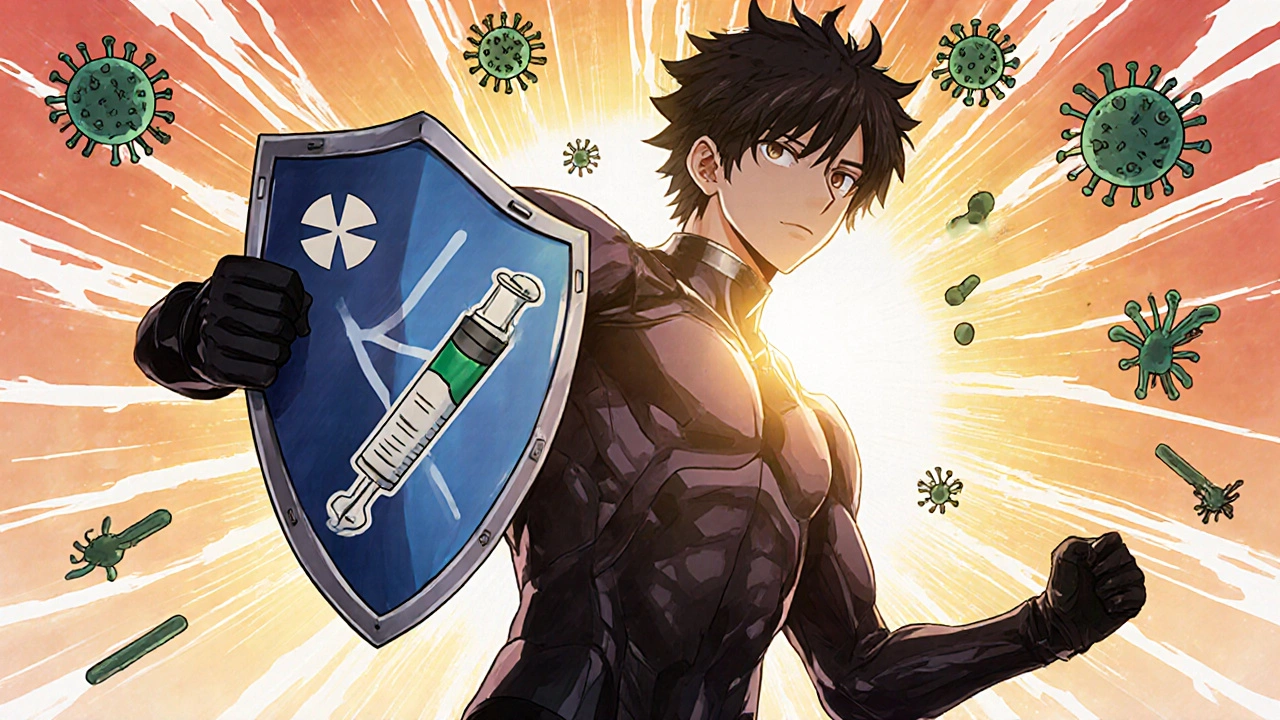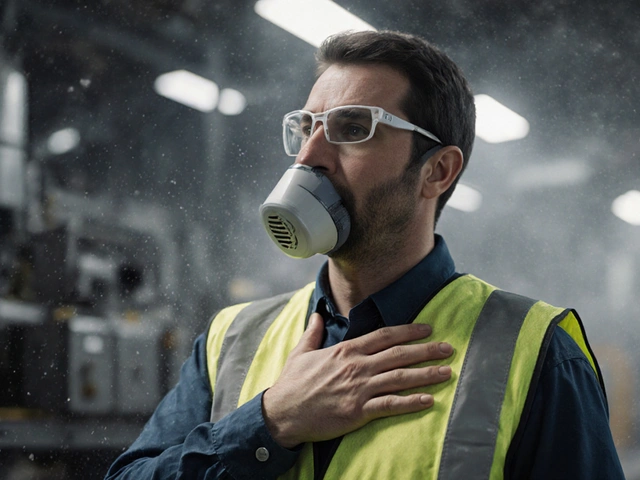Cyclosporine Infection Symptom Checker
Check Your Symptoms
This tool helps you identify potential infection symptoms while taking cyclosporine. If you experience multiple symptoms, contact your healthcare provider immediately.
Cyclosporine is a calcineurin inhibitor used to suppress the immune system in organ transplant recipients and certain autoimmune diseases. While it saves lives by preventing organ rejection, it also opens the door to infections. This guide breaks down why the drug raises infection risk, what signs to watch for, and how patients can stay safe.
How Cyclosporine Affects the Immune System
Cyclosporine works by blocking the activity of calcineurin, a protein that activates T‑cells. T‑cells are crucial for recognizing and destroying pathogens. By dampening this pathway, the drug creates a state of Immunosuppression that is intentional for transplant patients but also reduces the body’s natural defense against bacteria, viruses, and fungi.
Why Infection Risk Increases
When T‑cell function is blunted, several defense mechanisms falter:
- Reduced cytokine production means fewer signals to recruit immune cells.
- Impaired activation of macrophages hampers the clearance of intracellular microbes.
- Lowered antibody responses limit protection against extracellular pathogens.
The net effect is a higher chance of both common community infections and opportunistic organisms that rarely cause disease in healthy people.
Common Infections Seen with Cyclosporine
Not every infection will happen to every patient, but studies give us a sense of which bugs show up most often. The table below summarizes prevalence rates reported in recent transplant cohorts (2022‑2024).
| Infection Type | Typical Incidence (per 100 patient‑years) | Notes |
|---|---|---|
| Upper respiratory tract infections | 45 | Mostly mild, but can progress in immunosuppressed hosts |
| Urinary tract infections (UTI) | 30 | E. coli most common; consider prophylaxis after bladder catheters |
| Cytomegalovirus (CMV) disease | 12 | Cytomegalovirus reactivation is a leading cause of morbidity in transplant patients |
| Pneumocystis jirovecii pneumonia (PJP) | 5 | Opportunistic fungus; prophylaxis with TMP‑SMX reduces risk |
| Mycobacterial tuberculosis | 2 | Risk higher in endemic regions; screen before starting cyclosporine |
| Staphylococcus aureus (including MRSA) | 8 | Skin and soft‑tissue infections; watch for surgical site involvement |
| Fungal infections (Candida, Aspergillus) | 3 | Often linked to invasive lines or prolonged neutropenia |
Monitoring and Early Detection
Timely detection saves lives. Most transplant centers schedule routine labs every 1‑2 weeks for the first three months, then monthly. Key tests include:
- Complete blood count (CBC) - watches for neutropenia, a risk factor for bacterial/fungal infection.
- Liver function tests - cyclosporine can cause hepatic toxicity that mimics infection.
- CMV PCR - quantifies viral load before symptoms appear.
- Chest X‑ray or CT when respiratory symptoms develop.
Patients should also learn the early warning signs that warrant a call to their care team: fever >38°C (100.4°F) lasting >24 hours, persistent cough, new rash, painful urination, or unexplained fatigue.
Prevention Strategies
Prevention is a collaborative effort between the patient, the transplant team, and sometimes an infectious‑disease specialist.
Vaccination
Before starting cyclosporine, most clinicians recommend a pre‑transplant vaccine series:
- Influenza (inactivated) annually.
- COVID‑19 booster according to current guidelines.
- Pneumococcal (PCV13 followed by PPSV23).
- Hepatitis B for those at risk.
Live vaccines (e.g., MMR, varicella) are generally avoided once cyclosporine is underway because the immune response may be insufficient.
Prophylactic Antibiotics and Antivirals
Standard regimens include:
- Trimethoprim‑sulfamethoxazole (TMP‑SMX) for Pneumocystis jirovecii pneumonia prophylaxis for the first 6‑12 months.
- Valganciclovir for CMV‑seropositive patients, often for 3-6 months post‑transplant.
- Fluconazole for high‑risk patients to prevent candidiasis.
Hygiene and Lifestyle
Simple habits go a long way:
- Hand‑washing with soap before meals and after using the bathroom.
- Avoiding close contact with sick individuals during flu season.
- Cooking meats thoroughly; steering clear of raw or undercooked seafood.
- Safe food storage to prevent Listeria, especially for transplant recipients.
Managing an Active Infection
If an infection does break through, prompt treatment is essential. The approach typically involves:
- Identifying the pathogen via cultures, PCR, or imaging.
- Adjusting the cyclosporine dose - sometimes a temporary reduction is needed, but never stop abruptly without medical advice.
- Starting pathogen‑specific therapy (e.g., intravenous antibiotics for sepsis, antiviral agents for CMV).
- Monitoring drug levels - cyclosporine has a narrow therapeutic window; infection can alter its metabolism.
Close coordination with the transplant team ensures the balance between preventing rejection and fighting the infection.

Alternative Immunosuppressants and Their Infection Profiles
Patients sometimes wonder if switching drugs could lower infection risk. Below is a quick comparison of the three most common calcineurin‑based agents.
| Drug | Mechanism | Typical Infection Rate (per 100 PY) | Notable Advantages |
|---|---|---|---|
| Cyclosporine | Calcineurin inhibitor | ≈ 70 overall (includes viral, bacterial, fungal) | Long‑track record, lower cost |
| Tacrolimus | Calcineurin inhibitor (more potent) | ≈ 65 overall; higher risk of neurotoxicity | Better renal sparing in some patients |
| Mycophenolate mofetil | Antimetabolite (inhibits guanine synthesis) | ≈ 55 overall; more GI upset | Lower nephrotoxicity, often used in combination |
Each drug has its own side‑effect profile. Switching should only happen under specialist guidance, balancing rejection risk, kidney function, and infection history.
Key Takeaways
- Cyclosporine’s immunosuppressive action makes infection a real concern.
- Common infections include respiratory viruses, UTIs, CMV, and PJP.
- Regular lab monitoring and early symptom reporting are vital.
- Vaccination, prophylactic meds, and good hygiene dramatically lower risk.
- If an infection occurs, prompt treatment and possible dose adjustment are essential.
Frequently Asked Questions
Can I get the flu vaccine while on cyclosporine?
Yes. The inactivated flu shot is safe and recommended for anyone taking cyclosporine. Live‑attenuated nasal sprays should be avoided.
How long does the increased infection risk last?
Risk is highest during the first 6‑12 months after starting therapy, when drug levels are often at their peak. Long‑term users still have a modestly elevated risk compared to the general population.
Should I stop cyclosporine if I develop a fever?
Never stop the drug on your own. Contact your transplant or rheumatology team immediately; they may adjust the dose while treating the infection.
Are there food restrictions while on cyclosporine?
Cyclosporine levels can rise with grapefruit juice and some high‑fat meals. Stick to a balanced diet and avoid grapefruit products unless your doctor says otherwise.
What is the most common serious infection with cyclosporine?
Cytomegalovirus (CMV) disease is a leading cause of serious illness, especially in the first year post‑transplant. Routine CMV PCR screening helps catch it early.







Albert Fernàndez Chacón
October 18, 2025 AT 13:47Cyclosporine definitely tones down the immune response, which is why infection vigilance is key. I appreciate the clear breakdown of common pathogens and the monitoring schedule. Keeping an eye on fever and lab values can catch problems early, especially in the first few months.
Matthew Miller
October 24, 2025 AT 08:40Wow, this guide is a powerhouse of practical tips! From vaccination schedules to hygiene hacks, it nails every angle. Stay sharp, fellow transplant warriors-your health is worth the hustle!
Alex Lineses
October 30, 2025 AT 02:33Navigating cyclosporine therapy can feel like walking a tightrope between preventing rejection and avoiding infection, but with the right strategies you can stay balanced. First, understand that calcineurin inhibition dampens T‑cell activation, which compromises both cell‑mediated and humoral immunity. Because of this, opportunistic pathogens such as Pneumocystis jirovecii and Cytomegalovirus become real threats, especially during the initial 6‑12 months of treatment. Routine surveillance labs-CBC, liver panels, and CMV PCR-serve as early warning lights; any trend toward neutropenia or rising viral loads should trigger a prompt clinical assessment. Vaccination is another cornerstone; an inactivated influenza shot each season and a PCV13 followed by PPSV23 series dramatically lower respiratory infection risk. Avoid live attenuated vaccines like MMR until your immunosuppression level is reduced, because the attenuated organisms may still cause disease in a weakened host. Prophylactic antimicrobial regimens, such as trimethoprim‑sulfamethoxazole for PJP and valganciclovir for CMV-seropositive patients, have been shown in multiple cohort studies to cut serious infection rates by up to 50 percent. Nutrition and hygiene also play a supportive role; thorough hand‑washing, cooking meats to safe internal temperatures, and steering clear of unpasteurized dairy can prevent common bacterial culprits like E. coli and Listeria. When an infection does arise, coordination with your transplant team is vital; they may need to adjust cyclosporine dosing temporarily while initiating pathogen‑specific therapy. Dose reduction should never be done unilaterally, as abrupt changes can precipitate acute rejection, a risk that outweighs most infections. If you notice persistent fever above 38 °C for more than 24 hours, new cough, dysuria, or unexplained fatigue, call your care team immediately-early intervention saves lives. In terms of drug interactions, be mindful of grapefruit juice, which can increase cyclosporine serum concentrations and heighten nephrotoxicity. Similarly, certain antibiotics like azoles can inhibit CYP3A4 metabolism, requiring tighter therapeutic drug monitoring. Finally, keep a personal log of symptoms, medication changes, and lab results; this empowers you to spot patterns and communicate effectively with your providers. By integrating vigilant monitoring, preventive vaccinations, targeted prophylaxis, and lifestyle hygiene, you substantially mitigate infection risk while maintaining the immunosuppressive benefits of cyclosporine.
Brian Van Horne
November 4, 2025 AT 21:27Indeed, the prophylactic regimen delineated herein represents an elegant synthesis of evidence‑based medicine.
Joe Moore
November 10, 2025 AT 16:20Yo man they dont tell u that big pharma pushin cyclosporine just to make us sick so they can sell more antibiotics lol watch out for hidden agenda
Emma Williams
November 16, 2025 AT 11:13Thanks for the thorough guide – it really helps us stay on top of things
Janet Morales
November 22, 2025 AT 06:07Honestly, this whole obsession with prophylaxis feels like an over‑cautious nightmare; I’d rather take my chances and live a little instead of living in a sterile bubble.
Rajesh Singh
November 28, 2025 AT 01:00While I respect the medical necessity of cyclosporine, we must also hold ourselves accountable for maintaining impeccable hygiene and adhering strictly to vaccination schedules, lest we betray our own health in the name of convenience.
Drew Waggoner
December 3, 2025 AT 19:53Reading this makes me think about all the times I've watched friends suffer from infections that could've been prevented – it’s a relentless reminder of how fragile we truly are.
Mike Hamilton
December 9, 2025 AT 14:47Life is like a immune system you cant see – you gotta balance the strong and the weak and sometimes a little cyclosporine can tip the scale but i guess we all learn to walk that line
Liberty Moneybomb
December 15, 2025 AT 09:40Can you imagine that the very labs they use to monitor our cyclosporine levels are secretly calibrated to keep us in the dark about real outbreaks? The drama of being constantly monitored is enough to make anyone feel trapped!
Norman Adams
December 21, 2025 AT 04:33Oh brilliant, another checklist of prophylactic pills – as if we’re all just walking pharmacies waiting for the next infection to RSVP.